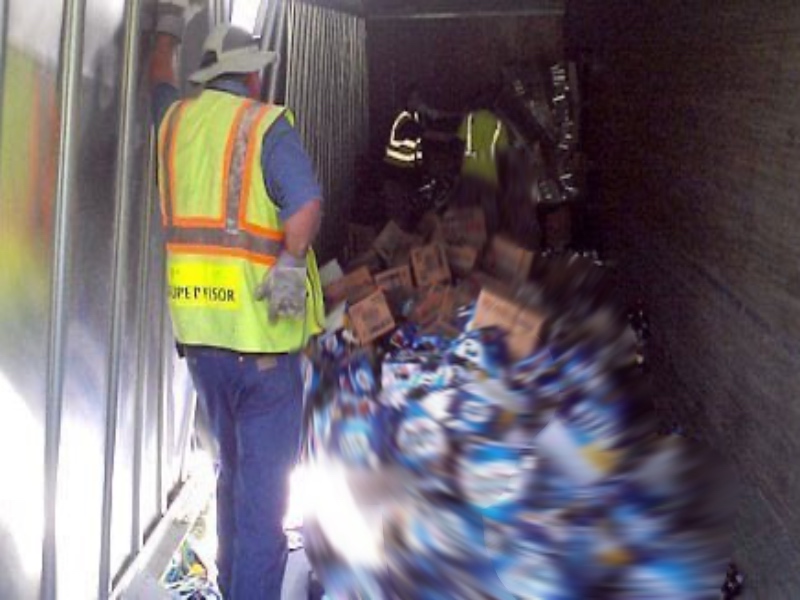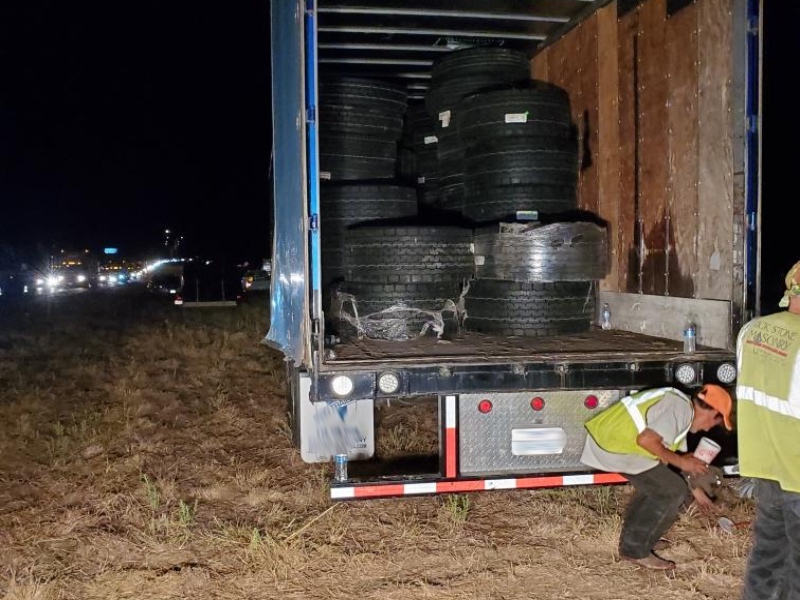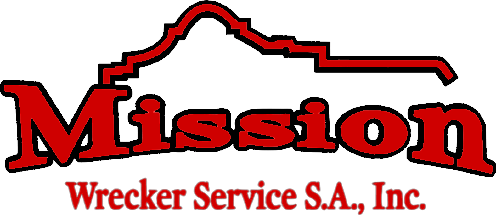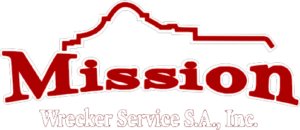The Cargo Spill Cleanup Process
A tractor-trailer rollover with spilled cargo blocks lanes, slows emergency response, and endangers other drivers. Each minute the material stays on the pavement adds risk for the traveling public and cleanup crews. Every San Antonio heavy recovery involving a cargo spill requires a coordinated and immediate plan. Cargo on the highway can be unstable, scattered, or leaking. The type of freight inside the trailer determines how our tow truck operators secure, move, and dispose of it. Knowing the contents and condition of the load shapes the entire recovery operation.

The Risk of Delaying Cargo Spill Response
When a trailer tips over and its contents spill, the road surface becomes unpredictable. Cargo may obstruct lanes, create obstacles, or cause vehicles to swerve into oncoming traffic. Fuel or other liquids leaking from the truck can increase the danger to drivers and workers.
Weather accelerates the problem. Rain weakens packaging, spreads liquids, and creates slick conditions. Heat can cause certain materials to expand or degrade, making recovery more difficult. Acting quickly protects drivers, preserves usable cargo, and prevents more extensive cleanup later.
Environmental and legal factors also play a role. Some spills require formal reporting to regulatory agencies. Others involve coordination with hazmat teams. Following proper protocols is as important as moving the freight itself.
Our Response Plan
When a San Antonio heavy recovery call involves a cargo spill, our recovery efforts could look like the following: we start by collecting detailed information from dispatch. We confirm the cargo type, trailer condition, location, and whether any hazardous materials or fluids are involved.
We deploy a team with equipment matched to the scene. This can include:
- Loaders and skid steers to lift or move material
- Heavy-duty wreckers for tractor and trailer recovery
- Containment and absorbents for oil, fuel, or chemical leaks
- Traffic control systems such as cones, signage, and lighting
At the site we first secure the area, then stabilize the vehicle to prevent further shifting. Once the area is safe, we begin the process of removing cargo and clearing the roadway.
A Step-by-Step Cleanup
Each San Antonio heavy recovery involving a cargo spill could follow this structured sequence (depending on the road condition and cargo type we’re working with):
- Initial Assessment
Evaluate hazards, cargo type, and site conditions. - Vehicle and Site Stabilization
Secure the truck and spilled materials before moving anything. - Material Handling
Remove or relocate cargo using the right tools and equipment. - Vehicle Recovery
Tow or upright the trailer and tractor. - Scene Remediation
Sweep, apply absorbents, and clear the area of debris. - Documentation
Record the process for insurance, legal, or regulatory needs.
This approach keeps the cleanup organized, protects responders, and helps reopen the roadway sooner.
Training and Experience Guide Every Action
Cargo recovery requires more than heavy equipment. It involves knowledge of freight types, hazardous material protocols, and salvage practices. Our operators train regularly to stay current with transportation regulations and recovery techniques.
When a load contains mixed or damaged goods, the decision to salvage, store, or discard material must be made quickly and accurately. We coordinate directly with shippers, insurance representatives, and law enforcement at the scene to ensure each step is handled correctly.
We also provide thorough post-incident records. This documentation supports insurance claims, satisfies regulatory requirements, and gives all parties a clear picture of what was done on-site.
San Antonio Heavy Recovery FAQ: Fast Cargo Spill Cleanup
1. Why is cargo spill cleanup so urgent on highways?
Spilled cargo quickly becomes a hazard for drivers and cleanup crews. Every minute it stays on the road increases:
- The chance of secondary accidents
- Damage to the cargo itself
- Environmental risks from leaks or spills
Quick action keeps traffic moving and reduces danger for everyone.
2. What are the biggest risks when a trailer tips and spills its load?
- Obstructed lanes that cause drivers to swerve or stop suddenly
- Unstable debris or pallets that can shift or slide into traffic
- Fuel or fluid leaks that create slick surfaces or environmental hazards
- Weather-related issues, like rain spreading liquids or breaking down packaging
3. How do weather conditions make cleanup harder?
- Rain weakens packaging and spreads liquids across the roadway
- Heat can cause some cargo to expand, spoil, or become unstable
- Wind can scatter debris farther down the highway
All of these slow the cleanup process and increase risks for drivers and responders.
4. What’s the first step when a cargo spill is reported?
The recovery team collects detailed information before arriving:
- Type of cargo and whether it’s hazardous
- Condition of the trailer and spill location
- Road conditions and any immediate threats to traffic
This ensures the right equipment and safety measures are deployed.
5. What kind of equipment is used for San Antonio heavy recovery after a spill?
Mission Wrecker deploys:
- Loaders and skid steers for heavy debris
- Heavy-duty wreckers for truck and trailer recovery
- Containment tools and absorbents for oil, fuel, or chemical spills
- Traffic control systems like cones, lights, and signage to keep the scene safe
6. What does a typical cargo spill cleanup process involve?
A structured approach often includes:
- Initial assessment to identify hazards and cargo type
- Stabilizing the truck and site to prevent further shifting
- Handling materials safely using the right tools
- Vehicle recovery to move or upright the trailer
- Scene remediation with sweeping, absorbents, and debris removal
- Documentation for insurance, legal, or regulatory purposes
7. How do recovery crews handle hazardous or mixed cargo?
Crews follow strict protocols for hazardous materials and coordinate with:
- Hazmat teams and environmental agencies for compliance
- Shippers and insurers to decide whether goods should be salvaged, stored, or discarded
Quick, correct decisions reduce risks and protect valuable cargo.
8. Who manages traffic control during a cargo cleanup?
Traffic safety is a joint effort:
- Law enforcement and DOT typically manage lane closures and traffic flow
- The recovery crew sets up cones, flares, and lighting to create a secure work zone
This coordination keeps responders safe and minimizes delays for drivers.
9. Why is documentation important after a cargo spill recovery?
Thorough records:
- Support insurance claims and incident reports
- Demonstrate compliance with environmental and safety regulations
- Provide a transparent account of how the cleanup was performed
10. Why call Mission Wrecker for San Antonio heavy recovery?
Because we:
- Respond fast to protect drivers and reduce secondary crashes
- Bring specialized equipment and trained crews for all types of cargo spills
- Work closely with law enforcement, hazmat, and shippers to handle the situation efficiently
- Keep the focus on speed, organization, and safety to get traffic moving again

San Antonio Heavy Recovery: Mission Wrecker Handles the Tough Jobs
Cargo spills create immediate hazards for drivers and responders. Our San Antonio heavy recovery crews bring equipment, training, and a proven process to every call. We stabilize the scene, remove spilled materials, recover vehicles, and return the roadway to a safe condition.
Our San Antonio heavy recovery approach is built on speed, organization, and safety. Each San Antonio heavy recovery is handled from start to finish with full attention to the details that matter most.
If a cargo spill blocks the road, we’re ready to respond and restore order.

